Red pimples on the body cause a lot of inconvenience to their “owner”. Rashes can appear at any time, especially annoying when it happens before an important meeting or event. Many pimples are accompanied by an acute inflammatory process and pain, others disappear on their own, without causing any inconvenience to the person, except for aesthetic unattractiveness. What could it be and what to do if red rashes appear?
Unfavorable factors affecting the formation of acne
Red pimples on the body occur due to certain reasons.
The most common provoking factors are:
- Deficiency of useful components . Small pimples on the body of an adult are often caused by a lack of vitamins and minerals. This process leads to disruption of the functioning of organs and systems, which is accompanied by damage to the upper layer of the skin.
- Digestive system disorders . Often small pimples on the body, in particular on the face, indicate problems with the gastrointestinal tract. Rashes can be triggered by poor diet, consumption of junk food and constant overeating.
- Allergic reaction to cosmetics . Itchy pimples after applying your favorite cream indicate its intolerance by the body, that is, the development of an allergy. In this case, the components of the product clog the pores, causing profuse rashes in the form of red dots on the body and inflammation.
- Hormonal imbalances provoke the formationacne on the back and other parts of the body. Peak hormone activity occurs during adolescence. Small pimples on the body of women are associated with the phase of the menstrual cycle; pimples often appear before menstruation.
- Systematic nervous tension . Stress and nervousness negatively affect the functioning of all organs and systems of the body. Disturbances in coordinated functioning contribute to the appearance of acne throughout the body.
- Periodically occurring rashes are a consequence exposure to external stimuli on the body . These include temperature changes, fabrics and allergens.
- Insufficient hygiene . Lack of proper skin care increases the risk of developing inflammatory processes. Small pimples on the body act as a natural reaction of the body to non-compliance with hygiene procedures.
It is important to remember that only a doctor can determine the true reason why pimples appear. All of the above factors are harmless. Serious diseases of both the skin and internal organs can lead to the formation of pimples on the body of an adult.
Allergic dermatitis
Red pimples on the body are often the result of an allergic reaction. Excessive rashes can appear if you choose the wrong cosmetic and care product. Often their development is due to the negative impact of biological and physical factors.
Allergic type dermatitis provokes small red pimples on the skin. Medicinal and chemical substances act as potentially dangerous allergens. People often experience an allergic reaction in the form of red dots on their legs and arms to the components contained in washing powder. Pimples on the scalp in the hair of men and women can be a consequence of individual intolerance to the components of the shampoo.
Allergic type dermatitis is characterized by the following symptoms:
- small red rashes ;
- itching ;
- the appearance of crusts on the skin .
Acne on the skin is eliminated by eliminating the allergen. A person needs to reduce or completely eliminate contact with a potentially dangerous substance. For a speedy recovery, it is advisable to use topical ointments, in particular Fenistil and Akriderm. In acute cases of the disease, it is necessary to use systemic anti-allergy medications - Claritin and Cetrin.
Prurigo: purulent papules
Pimples on the body itch due to the development of prurigo; this disease is characterized by the formation of papules. As the pathology progresses, pus forms in their cavity. Prurigo, or prurigo (the medical name of the disease) is recorded in both children and adults. In babies it is a reaction to complementary foods.
Rashes appear on the body due to the negative effects of infectious agents, chronic diseases and helminthic infestations. Pink pimples indicate the development of pathology; it is possible that pimples may form, which eventually become covered with a thin crust. They can be very itchy, which forces a person to scratch the skin until red spots appear.
Systematic mechanical damage leads to the appearance of dense nodules, the diameter of which reaches 5 mm. Pimples itch, causing general discomfort. The child may experience loss of appetite, increased irritability and sleep disturbances. Adults tolerate prurigo more easily; they experience only intense itching. It is not recommended to scratch the rash; there remains a high risk of infection, which is accompanied by suppuration.
Skin treatment involves following a diet. Potentially dangerous allergens must be removed from the diet. Additionally, it is recommended to avoid spicy, smoked and fatty foods. A person needs to normalize the functioning of the digestive system and prevent constipation. To speed up the recovery of the body, antihistamines are used: Loratadine, Diazolin and Clemastine. The rash becomes smaller on the second day after the start of treatment.
Scabies and demodicosis
Pimples on the body itch due to damage to the skin by potentially dangerous microorganisms. Parasitic diseases caused by their exposure are accompanied by red pimples and pimples on the body and unbearable itching. The most common pathologies are scabies and demodicosis.
The rashes that appear are caused by the penetration of the female scabies mite under the skin. They lay larvae in the upper layers of the epidermis, causing the formation of small papules and blisters. Treatment consists of constantly changing bed linen, following a diet and using medications. The most popular medical products are Lindane, Ivermectin, Spregal and sulfur ointment. The preparations are applied to the skin in a thin layer, several times a day.
Treatment of scabies and demodicosis is carried out in the evening, this is due to the nocturnal activity of pathogens. The optimal treatment regimen is prescribed by a doctor based on laboratory tests.
Folliculitis
Do small pimples itch on your body, but general discomfort affects your quality of life? The development of folliculitis cannot be ruled out. This disease is accompanied by the formation of papules, pimples and blackheads on the scalp. Small rashes appear throughout the body. Red pustules often appear on the trunk and limbs. Their development is caused by damage to the skin by staphylococci and streptococci.
Itchy rashes are a consequence of weakened protective functions of the body, unbalanced nutrition, excessive sweating and disturbances in the functioning of the endocrine system. This disease can be eliminated through diet and topical medications. Small rashes disappear 3-5 days after the start of intensive therapy.
To treat fungal folliculitis, antifungal drugs are used, in particular Nizoral and Exoderil. If the pathology is caused by a viral infection of the body, Acyclovir is used.
Viral diseases
The body itches in different places due to a viral infection of the skin. Pathogenic agents cause the development of herpes zoster and lichen. Large pimples and blisters appear on the body; they itch intensely, causing a lot of inconvenience to the person. They appear on any part of the skin and are accompanied by the formation of crusts. When blisters develop, a person becomes dangerous to the people around him.
The development of viral-type pathologies is provoked by a decrease in the body’s protective functions, stressful situations, long-term use of antibiotics and the development of oncology. A distinctive feature of shingles is the rapid progression and appearance of acne in pairs.
Treatment of herpes and other viral pathologies involves the use of antiviral drugs - Acyclovir, Pentalgin and Diclofenac. The use of these remedies eliminates rashes, pain and inflammation. The skin is constantly cleansed with ordinary water; skin care products are prohibited. Bed linen is changed daily, a person uses an individual towel and household items.
Hormonal disorders
In adolescence, a rash appears under the influence of hormonal imbalances. There are not so few rashes; they are localized mainly on the face, neck and chest area. Dense acne on the body does not cause discomfort. The bluish-red hue of the rash attracts attention. However, apart from being aesthetically unattractive, the rashes do not pose any danger. Read more about acne treatment →
The rash can also appear in women, depending on the phase of the menstrual cycle and the general condition of the body. If there are rashes caused by hormonal imbalances, no special treatment is required. It is enough to normalize your diet and monitor the skincare products you use. If painful and profuse rashes appear, and this process is systematic, it is advisable to check the level of hormones.
There are many provoking factors that cause the development of formations. If one pimple pops up, and a similar phenomenon occurs periodically, there should be no reason to worry. If itchy blisters form, accompanied by pain and burning, it is advisable to visit a doctor.
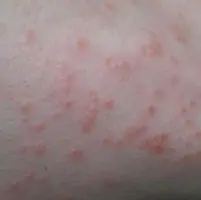
Acne all over the body can appear at any time in life, both in adults and in young children. But the worst thing is that the rash can be accompanied by unpleasant symptoms and an inflammatory process. And it, in turn, is a very favorable soil for the addition of a bacterial or fungal infection.
Pimples on the body that itch need to be treated, but first you need to find out what exactly triggered their appearance. The causes of such an anomaly can be pathological and non-pathological.
Types of acne on the skin
Red bumps on the body have their own varieties. If you pay more attention to studying them, you can even independently understand what you are dealing with. Of course, only a doctor can make an accurate diagnosis, but you will at least approximately know about your problem.
So, what are the types of acne on the body?
- Vesicles. This rash resembles blisters and contains fluid inside. But, unlike them, the vesicle has clearly defined boundaries (blisters are “blurry” and can have different shapes). Vesicular rashes tend to spread over the surface of the skin and merge with each other. In most cases, they are the result of infectious (in particular, viral) lesions of the body.
- Acne. This is a problem that many people face, and their main mistake is that they try to get rid of the problem on their own. A closed comedone contains not only dust and subcutaneous sebum - underneath their layer there are bacteria, and if they are “disturbed”, intense inflammation can begin. The consequence of the development of this process will be the appearance of itchy pimples on the body.
- Papules. Such rashes are formed in various pathologies and consist of accumulated subcutaneous sebum, dead epidermal cells and pathogens. Such rashes look like small red bumps on the skin that itch or hurt. It is better not to squeeze them out yourself. The only thing that can be done is to apply compresses based on medicinal plants to such rashes. Ointments are used only as prescribed by a doctor.
- Closed comedones. Such pimples are also called millet pimples. They can be localized on any part of the body, but most often affect the face. They are almost invisible, but if you run your fingers over the problem area, you can feel that it is “strewn” with small tubercles. This is the millet. If they are injured, this can be the beginning of the development of serious inflammation and the appearance of large red pimples on the body.
- Pustules. This name refers to small pustules that appear all over the body. Trying to squeeze out such a pimple, a person only makes it worse, since it removes only the visible part of it. The rest of the contents go deeper into the underlying layers of the dermis, provoking the development of inflammation. As a result, red pimples appear on the body, which hurt and can fester even more.
- Nodules. Pimples on the body of an adult, in the form of nodules, are filled with purulent contents inside. They are pink or purple-red in color. In addition, infection easily penetrates into such nodules, which only aggravates the situation.
Important! In addition to the types of rashes described above, there are several other types of formations - boils, cysts and atheromas. These are one of the most dangerous neoplasms that require only a professional medical approach to the issue of therapy. These skin conditions may be accompanied by redness and pain, indicating the development of severe inflammation.
Factors that do not pose a threat to health
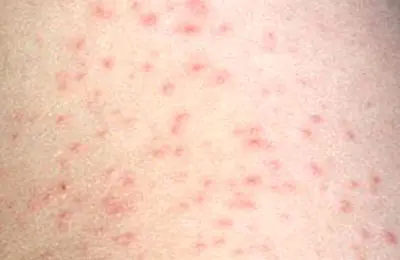
There are not many non-pathological causes of acne on the body of an adult. They include:
- Increased skin sensitivity. A sharp reaction of the body can be provoked by some elements of decorative cosmetics - powder or foundation - which are applied to the décolleté, arms, and neck. Poor-quality products lead to irritation of the epidermis, blockage of the sebaceous and sweat glands, which causes the formation of small red or white pimples on the body. Usually such rashes do not itch, but can hurt and cause severe aesthetic discomfort.
- Hormonal changes in the body. White pimples on the body are a problem primarily affecting women and teenagers. Representatives of the fairer sex have unstable hormonal levels, since this is influenced by several factors: the body’s preparation for menstruation, menstruation itself, pregnancy and the period of breastfeeding. Blackheads and pustules do not itch, but they can be painful. And there is nothing to say about aesthetic discomfort. Such rashes are a common occurrence among teenagers, because puberty is always accompanied by a serious hormonal surge.
- Nervous tension, constant stress, psycho-emotional shocks. If a person has small pimples on the body that itch, this may be a consequence of exhaustion of the nervous system. Moreover, stress and psycho-emotional stress are not always the cause of such a symptom. Lack of sleep, heavy mental work, depression - all these factors can also cause itching and small rashes on the skin.
- External stimuli. Sometimes the whole body itches, and small pimples appear on the body due to sudden changes in temperature, hard tap water, swimming in open water, etc. This is an acute skin reaction, which can only be eliminated if its provocateur is eliminated.
- Non-compliance or incomplete compliance with hygiene rules. A person often itches his entire body, and pimples appear when hygiene procedures are carried out too infrequently. This applies not only to the face, but also to the torso, so it is necessary to take a shower regularly, visit the sauna or bathhouse (if there are no contraindications), and use scrubs to clean the pores.
These are the causes of acne on the body that do not pose a health hazard. But this does not mean that you can close your eyes to the situation, because if the problem is not solved, then it may well develop into a skin disease.
Dangerous pathologies that cause acne
Pathological causes of acne throughout the body can be associated with various diseases. Moreover, not only skin ones. That is why it is important to know about them in order to promptly seek qualified help.
Avitaminosis
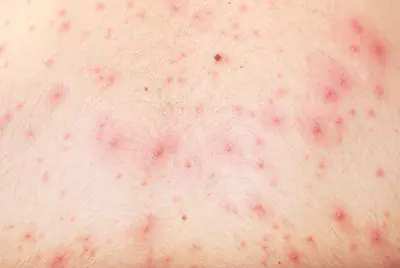
Vitamin deficiency is a lack of vitamins, which negatively affects the functioning of the entire body. Small pimples on the body can be one of the symptoms of this pathological abnormality. At the same time, a person develops pale skin, weakness, tremors in the limbs, peeling nails, brittle hair, etc.
Malfunction of the gastrointestinal tract
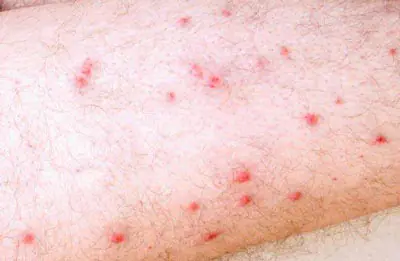
Very often, small pimples on the body, and especially on the face, indicate problems with the digestive tract. They can itch, ulcerate, become inflamed, and become scaly. As a rule, in parallel, a person notices problems with digestion. They are manifested by frequent hiccups, belching, heartburn, epigastric pain, constipation or diarrhea, etc.
Allergy
Perhaps one of the most common reasons for the appearance of small red pimples on the body of an adult. Reactions to medications and insect bites are especially dangerous, as they can lead to angioedema or anaphylaxis. And these conditions are quite capable of ending in death.

If the whole body itches and red pimples appear after contact with the skin of chemical compounds, pollen, or low-quality cosmetics, then we are talking about contact dermatitis. This condition is very unpleasant, but at least not life-threatening.
Papulosis
If your feet itch and pimples appear, you may be talking about such an unpleasant disease as prurigo. It is accompanied by the formation of papules. The second name is prurigo. In the advanced phase of the pathology, pus accumulates inside the papules, which only aggravates the patient’s condition and aggravates the course of the disease.
Important! Do not scratch the papules, otherwise there is a high probability of secondary infection!
Parasitic lesions
If a person has red pimples on his stomach and they itch very much, this may indicate a disease such as scabies. Typically, the scabies mite first affects the abdomen, after which it “switches” to the arms, legs, and back. If you look closely at the affected areas, you will notice small “movements” in the skin. It is in them that the tick lives.
Demodicosis is another parasitic skin disease in which pimples on the body of an adult itch. It is caused by the demodex mite and has a clinical picture similar to scabies.
Herpes
Herpes is a viral disease, which is characterized by the patient complaining that the skin itches and pimples appear. The pathology is caused by the human herpes virus:
- The first type. Causes the appearance of a vesicular rash on the face and mucous membranes of the mouth and nasal cavity.
- The second type. It provokes the appearance of pimples on the skin of the genitals, which itch and hurt.
- Third type. This virus is called Varicella-Zoster. It causes the development of herpes zoster and chickenpox. In this case, small pimples on an adult’s body itch, hurt, and burst. They can appear on any part of the body - legs, arms, torso.
On a note. Bumps on the body with herpes zoster are the most painful and unpleasant. The fact is that Varicella-Zoster is a virus that affects not the skin, but the nerve endings. That is why pain is felt along the nerve fiber affected by type 3 herpesvirus.
Can red rashes be cured?
If red pimples itch, hurt, and cause discomfort, can they be cured? It is possible if you find out exactly the reason for their appearance.
So, for allergies, antihistamines for systemic (internal) or external use will help. Adults are prescribed tablets, children – syrups.
Sulfur ointment helps a lot with scabies. But it has a very specific smell, which, moreover, “eats” into the skin and clothes. It is important to wash and steam your laundry daily, after which it needs to be ironed with a hot iron.
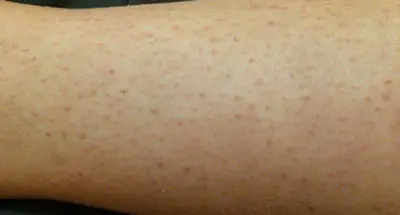
Boils, cysts and atheromas are treated exclusively by surgery. They should not be heated or pressed - this can lead to a breakthrough of the abscess into the underlying layers of the dermis. The spread of a purulent process to soft tissue can provoke phlegmon or an abscess.
Herpes, no matter what type of virus it is caused by, requires the use of antiviral agents: Acyclovir, Famvir, Gerpevir. In this case, systemic medications must be supplemented with ointments. For herpes zoster, additional auxiliary medications may be prescribed - painkillers and antipyretics.
Fungal infections are treated with antimycotics. They can also be systemic and local (tablets or capsules plus ointments, creams, gels).
There are many treatment methods, so a person without the necessary knowledge base in the field of medicine may well get confused in them. And there is nothing worse than incorrectly prescribed therapy. Therefore, the only correct way out when acne appears all over the body is to contact a dermatologist and undergo the examinations prescribed by him.
Hello, dear friends! Such a problem as red acne on the face is known to every person. Both teenagers and adult men and women are faced with it. Stress, a negative environmental situation, poor nutrition and other “companions” of the inhabitants of megacities are increasingly having an adverse effect every day.
Because of this, red pimples appear on the face, which are very difficult to deal with. But it is imperative to take measures to eliminate them, since they cause physical and aesthetic discomfort.
Bright red acne on the face: causes and treatment
The causes of acne can be varied. Therefore, in order to take effective measures to eliminate them, it is necessary to find out why exactly they jump up. This will allow you to choose a treatment method. Acne can be caused by:
- drinking alcohol and smoking;
- improper functioning of the sebaceous glands;
- stress and emotional overstrain;
- disturbances in the functioning of the gastrointestinal tract;
- improper skin care;
- regular consumption of spicy, fried and fatty foods;
- hormonal imbalances in the body.
Before taking measures to treat acne, you should find out the cause of its formation. Under some circumstances, it is possible to exclude those moments that provoke the appearance of acne. Otherwise, professional consultation and treatment may be required, involving the use of modern techniques.
How to quickly fix the problem
It often happens that a person has to go to an important event, and suddenly a pimple appears on his face. You have to act urgently, since there is no time to wait for the effect of using lotions.
There is only one way out of such situations - squeezing out the acne. Cosmetologists do not recommend doing this, since you can get an infection and only worsen the problem, but with the right approach, the risk of infection is minimal. When carrying out the procedure, it is important to adhere to the following rules:
- Before squeezing a pimple, you need to find out what type it is. It is allowed to remove only those eels that are already ripe. To determine this, you should apply gentle pressure around the area where there is inflammation. If there is pain, then nothing else can be done. You need to wait a little, otherwise a small pimple will be replaced by huge swelling, and maybe the spread of infection. Then you will have to refuse to attend the event.
- If the pimples are ripe, then prepare a cotton swab, a magnifying glass, a little alcohol for disinfection and take care of high-quality lighting. Hands and the sore area should be treated with alcohol to prevent infection.
- You need to very carefully press on the middle of the pimple. Everything needs to be done so as not to affect the surrounding areas of the skin. The force that pushes out the pus must come from below the fat duct. If you do everything exactly this way, then there will be no pus left at the bottom of the pore.
- Try to squeeze out the pus immediately so as not to unnecessarily disturb the damaged area.
- It is important to disinfect the wound with alcohol.
- One hour after the manipulation, apply Levomikol or Baziron ointment.
- To ensure that the swelling goes away as quickly as possible, do not apply makeup on the day of the procedure.
Homemade masks
Advertised products used by cosmetologists in salons cannot always help achieve the desired effect. Every girl can get rid of red pimples on her own. Simply taking proper care of your skin is enough. After performing water procedures in the morning, you need to wipe your face with a disinfectant tonic lotion.
Cosmetologists advise home treatment with anti-inflammatory masks. These are special formulations based on simple ingredients. So, different types of clay are suitable:
- Black clay is perfect for any skin type. You should mix two tablespoons of dry powder with a small portion of mint and string decoction. Mix everything until the consistency of a thick paste. Apply the mixture to your face. You should let the mask dry completely. Everything is washed off with warm water;
- If you have oily skin, you can prepare a preparation from green and white clay at home. You should mix one tablespoon at a time. of both products, add five drops of grape seed essential oil and a little non-carbonated mineral water;
- Sensitive skin is best treated with a white clay mask. It is recommended to dilute it with a medicinal infusion of chamomile;
- acne on the epidermis will go away if you apply a composition of blue clay to it. A couple of tablespoons of the substance should be mixed with water and a teaspoon of bodyaga powder. Apply the resulting mixture to your face, wait until it dries and rinse.
Cosmetics made from simple ingredients
You can also treat acne with other substances prepared at home. Calendula decoction will help eliminate acne. It is prepared like this: two teaspoons of dried flowers are poured with 400 milliliters of hot water and left for some time. Wipe your face with the strained tincture twice a day.
Soda-based lotions also provide good treatment. You need to dilute enough soda in water to create a thick porridge. Dip a piece of cotton wool into it and apply it to the inflamed areas for a couple of minutes.
Compresses made from green tea will also help get rid of red pimples.
Treatment for a disease such as acne can be achieved by wiping painful areas of the face with juice from freshly squeezed potatoes.
Aloe is a magical plant, the juice of which has a beneficial effect on the condition of the epidermis. If you have a pot with this representative of the flora on your windowsill, then you can safely use it for facial care. Cut a few aloe leaves and hide them in the refrigerator for three days. Later, finely chop the culture and squeeze the juice out of it. Before going to bed, simply wipe each pimple.
Another reliable way to get rid of acne
Peels are another reliable way to help get rid of acne. It is necessary to eliminate dead cells, since they are the reason why it is impossible to eliminate acne from your life forever. One of the scrubs is prepared like this: mix one tablespoon at a time. sour cream and fine coffee and massage the skin with this mixture for two minutes.
If you have large pimples, you should not rub your face too hard. The scrub is washed off with plain water and used only once a week.
After peeling, the skin can be lubricated with moisturizer.
Proper facial cleansing
If you have found out what causes the formation of acne on your face, you can do one of two things: get rid of it and wait until the condition of the skin improves on its own. Or you can do it another way: eliminate the factor that causes acne to appear and perform a number of home activities to promote recovery:
- Wash your face twice a day with antibacterial soap.
- Daily rubbing with ice cubes from an infusion of parsley, mint or sage will help relieve redness.
- Both internal and external pimples will disappear faster if you apply lemon slices to them for ten minutes.
- About three times a week, apply a protein mask (apply two beaten egg whites to the epidermis for a quarter of an hour) or a honey mask (liquid warm honey is applied like honey) to your face.
- Try not to touch your face and pimples with your hands or contaminated objects.
These recommendations can even be made by a doctor (cosmetologist), since they are basic care for acne-prone skin. Red acne is a kind of disease that requires no less scrupulous treatment than any other disease. If you want to eliminate acne quickly and for a long time, then the procedures must be done regularly until the result occurs.
How do you get rid of acne? Write in the comments!



